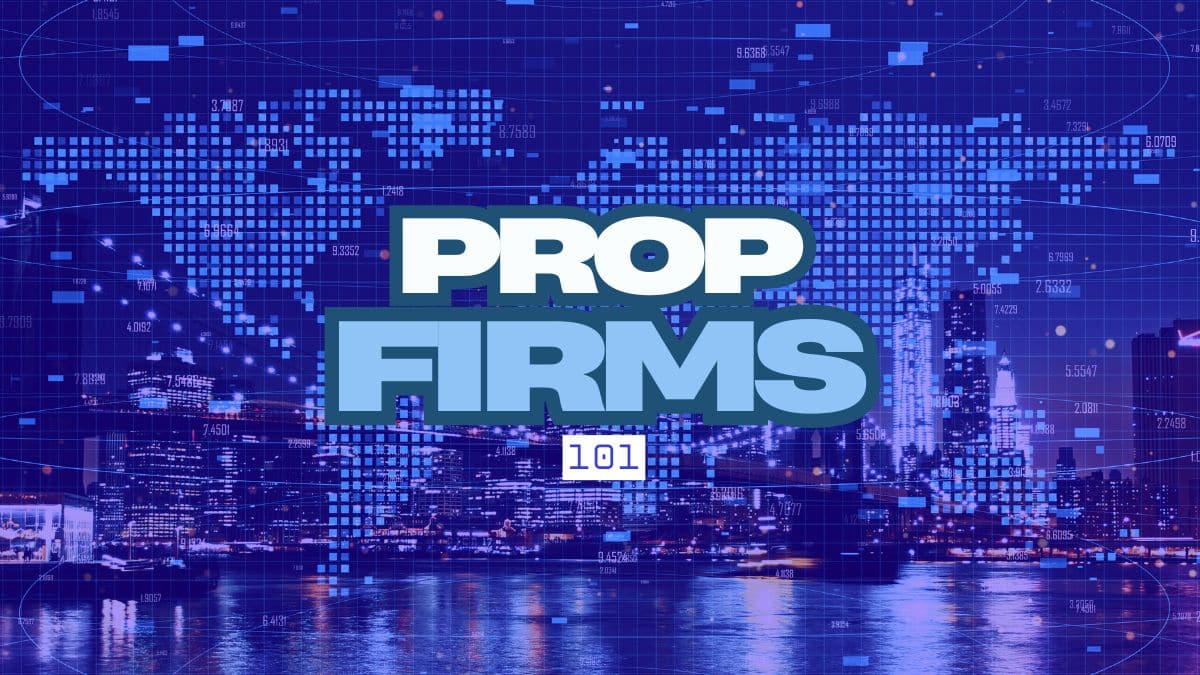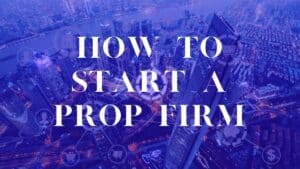What If You Could Trade Without Using Your Own Money?
Imagine trading with $100,000 instead of $1,000—and keeping up to 90% of the profits. That’s exactly what prop firms offer.
Prop trading gives traders access to large amounts of capital without risking their own money. Instead of using your savings, you trade with the firm’s capital and keep a percentage of the profits.
Prop firms have exploded in popularity because they allow traders to scale up faster than personal trading accounts ever could. However, most traders lose their accounts within weeks—not because the system is unfair, but because they aren’t prepared for the rules and pressure that come with trading large amounts of capital.
So, how do you get started? How do you choose the right prop firm? What are the risks?
Over the next few articles, you’ll learn everything you need to know about prop firms—how they work, how to pass a challenge, and how to trade profitably once you’re funded. Whether you’re considering forex, futures, or CFD prop firms, this series will give you the tools to succeed where most traders fail.
This isn’t just another surface-level guide. We’re diving deep into the mechanics of prop trading. Let’s start with the basics—how prop firms work and how to find the right one for you.

How Does a Prop Firm Work?
A prop firm provides traders with a funded account after they meet certain conditions. There are two main models for getting funded:
Challenge Model
- Traders must pass an evaluation (e.g., hit an 8–10% profit target).
- Strict rules on daily and total drawdown (e.g., 5% daily, 10% total).
- Evaluation fees usually range between $50–$500 depending on account size.
- If the trader passes the challenge, they receive a funded account and keep a percentage of the profits (typically 70%–90%).
Instant Funding Model
- No evaluation phase, but higher upfront cost (e.g., $200–$2,000).
- Stricter rules on maximum drawdown and trading consistency.
- Usually lower profit splits (e.g., 70%-80% instead of 90%).
- Best suited for traders who don’t want to go through the challenge process.
Once a trader has a funded account, they can trade using the firm’s capital. If they make profits, they keep a share of the earnings—usually between 80% and 90%. If they lose money, they don’t owe the firm anything beyond the initial fee.
Example:
If a trader makes $5,000 on a funded account with an 80% profit split, they keep $4,000 while the firm takes $1,000.
What Happens If You Lose a Funded Account?
The only money you lose when trading with a prop firm is the money you paid for the challenge or instant funding account. You never risk your personal savings.
However, if you break the firm’s rules (like exceeding the drawdown limit), the firm will revoke your funded account. If that happens, you’ll need to pass another challenge or buy another instant funding account to try again.
Risk Note:
“Trading with a prop firm offers significant advantages—but it also comes with risks. Make sure you understand the rules and potential downsides before getting started.”
Who Should Trade with a Prop Firm?
Trading with a prop firm is not for everyone. It can be a great opportunity, but it also requires discipline and knowledge.
Good candidates for prop firms:
- Traders who have experience but do not have enough personal capital.
- People who can follow strict risk management rules.
- Traders who are patient and willing to pass a challenge before getting funded.
Who should avoid prop firms:
- Beginners who do not have a proper trading strategy.
- Traders who take too many risks and do not follow rules.
- People who think trading is a way to get rich quickly.
Prop firms provide a way to trade with less personal risk, but success depends on skill and discipline. Most traders who join a prop firm fail, not because the system is unfair, but because they are not ready for the rules and pressure that come with managing large accounts.
What You Will Learn in This Guide
This guide will take you through everything you need to know about prop firms, including:
- What a prop firm is and how it works.
- The difference between challenge accounts and instant funding accounts.
- The best prop firms available today.
- A step-by-step guide on how to get funded.
- Trading strategies that increase your chances of success.
- Common mistakes that cause traders to lose their accounts.
By the end of this guide, you will understand how prop firms work, what to expect, and whether they are the right choice for you.
What is a Prop Firm and How Does It Work?
A prop firm (proprietary trading firm) provides traders with capital to trade in financial markets. Instead of using personal funds, traders use the firm’s money and keep a percentage of the profits—usually between 70% and 90%. This allows traders to take larger positions, access better spreads, and increase earnings faster than if they were relying on their own capital.
But there’s a catch. Prop firms don’t give money to just anyone. They have strict rules to protect their capital from inexperienced traders. Most firms require traders to pass an evaluation to prove they can trade profitably under specific conditions like profit targets, drawdown limits, and consistency rules.
This is where the Rule of 90 comes into play—a harsh but accurate reality in the trading world. The Rule of 90 states that 90% of new traders lose 90% of their capital within the first 90 days. This reflects the steep learning curve and the discipline required to succeed in trading. Most traders fail not because the system is unfair, but because they underestimate the mental strength and strategy needed to trade consistently.
Prop firms are no exception. They apply strict rules not to make things difficult, but to protect their capital from traders who aren’t ready. If you can’t prove that you can trade consistently and manage risk effectively, you won’t keep your funded account for long. This is why understanding the structure, rules, and expectations of prop firms is essential before getting started.
That said, not all prop firms are created equal. While some prop firms want you to succeed so they can profit from trading commissions, others make passing intentionally difficult to profit from challenge fees.
However, respected prop firms like FTMO and The 5%ers are built on sustainable models. Their goal is to create a win-win scenario where both the trader and the firm benefit from consistent, profitable performance. Knowing how to spot the difference between a fair and predatory prop firm is key to setting yourself up for success.
How Does a Prop Firm Make Money?
Many people wonder why prop firms are willing to give traders large amounts of money. The answer is simple: prop firms make money in two main ways:
Challenge Fees – Most prop firms require traders to pass a test before getting a funded account. This test is called a challenge or evaluation phase, and traders must pay a fee to enter. If the trader fails, the firm keeps the fee. If they pass, they get a funded account and a chance to trade real money.
Profit Sharing – When a funded trader makes profits, the prop firm takes a percentage of the earnings. Most firms offer traders 70% to 90% of the profit, while the firm keeps the rest. This way, the firm benefits from skilled traders who can consistently make money.
But that’s not the full story.
Some industry insiders believe that prop firms may also be profiting from trader data.
- Behavioral data – The trading habits and success rates of funded traders provide valuable insights into market sentiment and strategy efficiency.
- Order flow data – Knowing where traders place stop losses and profit targets could give prop firms (or their partners) a competitive edge in the market.
- AI training – The success and failure patterns of thousands of traders could be used to build or refine proprietary trading algorithms.
While most top-tier prop firms claim to operate on a profit-sharing model, it’s possible that some firms are monetizing trader behavior in ways that aren’t publicly disclosed. This doesn’t necessarily mean they are exploiting traders—but it highlights the value of trading data in the modern financial landscape.
The Two Types of Prop Firms
There are two main categories of prop firms based on the instruments they allow you to trade:
1. Challenge-Based Prop Firms
Challenge-based prop firms require traders to pass an evaluation phase before they can access a funded account. This test usually involves hitting a profit target while staying within strict risk limits.
How It Works:
- Traders must reach a set profit target (e.g., 8% to 10%) within a specific time frame (usually 30 days).
- There are strict rules on daily and overall drawdown (e.g., 5% daily, 10% total).
- If the trader fails, they must pay the challenge fee again to try again.
- If the trader passes, they receive a funded account and a profit split (typically 70% to 90%).
Examples:
✅ FTMO
✅ The Upside Funding
✅ Maven Trading
This model is more common because it helps firms filter out unskilled traders and protect their capital. It also encourages traders to follow strict risk management rules.
2. Instant Funding Prop Firms
Instant funding prop firms allow traders to skip the challenge phase and get a funded account immediately—at a higher cost. This model is designed for experienced traders who are confident in their ability to trade profitably.
👉 How It Works:
- Traders pay a higher upfront fee to access a funded account.
- Profit splits are often lower than challenge-based firms (e.g., 70% instead of 90%).
- Drawdown limits and consistency rules are usually stricter to protect the firm’s capital.
Examples:
✅ FundYourFX
✅ Instant Funding
✅ FTUK
This model works well for traders who already have a profitable strategy and want to scale up quickly without going through an evaluation phase.
3. Futures Prop Firms
In addition to forex prop firms, there are also futures prop firms that specialize in futures trading rather than forex or stocks. Futures trading involves contracts based on the future price of financial instruments like commodities, indices, and bonds.
Futures prop firms typically have different structures and risk models than forex prop firms:
- Futures trading often has lower leverage than forex.
- Many futures prop firms use profit targets and drawdown limits similar to challenge-based forex firms.
- Some futures prop firms focus more on order flow and market depth, which require different skill sets from forex trading.
Examples:
You can learn more about the best futures prop firms and how they work here.

What Are the Rules of a Prop Firm?
Every prop firm has a strict set of rules that traders must follow. These rules are not just designed to protect the firm’s capital—they’re also meant to test a trader’s ability to trade responsibly and consistently under pressure. Prop firms want to fund skilled traders who can manage risk and generate consistent profits.
Understanding these rules before starting with a prop firm is critical. Breaking the rules—even by accident—can result in losing your funded account, regardless of how profitable you’ve been.
1. Profit Target
Most challenge-based prop firms require traders to reach a profit target before they pass the evaluation phase. This target is usually between 8% and 10% of the starting balance within a fixed time period (e.g., 30 days).
- Example: If you start with a $100,000 challenge account and the profit target is 8%, you need to generate $8,000 in profit within the time frame to pass.
- Instant funding firms don’t have specific profit targets, but they often have tighter drawdown limits to offset this flexibility.
Why This Rule Exists:
- The profit target shows that you have the ability to generate consistent returns under controlled risk.
- It ensures that traders can trade effectively without relying on luck or excessive risk-taking.
2. Daily Drawdown Limit
The daily drawdown limit is the maximum amount you are allowed to lose in a single trading day. Most prop firms set this limit between 3% and 5% of the account balance.
- Example: If your account is $100,000 and the daily drawdown is 5%, you can’t lose more than $5,000 in a single day.
- If you hit this limit, your account is immediately closed for the day—and in many cases, you lose the account entirely.
Why This Rule Exists:
- It protects the firm from large single-day losses caused by reckless trading or market volatility.
- It forces traders to manage their position sizes and overall risk exposure carefully.
3. Overall Drawdown Limit
The overall drawdown limit is the maximum amount you are allowed to lose over the lifetime of the funded account. Most firms set this limit between 8% and 12% of the total account balance.
- Example: If your account is $100,000 and the total drawdown limit is 10%, your maximum cumulative loss can’t exceed $10,000.
- If you hit this limit at any time (even over multiple days), you lose the account.
Floating Drawdown vs. Static Drawdown:
- Floating Drawdown: Adjusts as the account grows. For example, if you increase your account balance to $120,000, a 10% drawdown would allow you to lose up to $12,000.
- Static Drawdown: Based on the starting balance. Even if your account grows to $120,000, the drawdown limit would remain fixed at $10,000.
Why This Rule Exists:
- It ensures traders don’t wipe out the firm’s capital through aggressive trading or poor risk management.
- It forces traders to think about long-term consistency rather than short-term wins.
4. Consistency Rule
Some prop firms require traders to generate profits consistently, rather than relying on one or two big trades. This rule prevents traders from gambling or relying on luck to pass the evaluation phase.
- Example: If you need to generate 8% profit over 30 days, but you make 7% of that in a single trade, you might fail the consistency rule—even if you hit the overall target.
- Some firms measure consistency by looking at daily profit distribution or average profit per trade.
Why This Rule Exists:
- It ensures traders can replicate performance over time, rather than relying on single high-risk trades.
- Prop firms want to fund traders who can trade professionally—not gamblers.
5. Trading Time Restrictions
Some prop firms restrict when and how traders can trade based on market conditions and risk factors.
🔸 News Trading: Some firms prohibit trading during high-impact news events (e.g., FOMC, NFP reports) because of extreme volatility.
🔸 Weekend Trading: Most firms require traders to close positions before the market closes for the weekend.
🔸 Overnight Holding: Some firms prohibit holding trades overnight to avoid gapping risk when markets reopen.
Why This Rule Exists:
- News-driven volatility can lead to slippage, increased spreads, and unpredictable market behavior.
- Holding trades over the weekend exposes the firm to uncontrollable market gaps.
6. Leverage Limits
Most forex prop firms allow leverage between 1:10 and 1:100, depending on the firm’s risk tolerance.
- Futures prop firms typically offer lower leverage (around 1:10 to 1:20) due to the higher notional value of futures contracts.
- Some firms offer lower leverage on volatile pairs or assets (e.g., exotic currencies or commodities).
Why This Rule Exists:
- Higher leverage increases both profit potential and risk exposure.
- Keeping leverage controlled protects both the trader and the firm from excessive risk.
What Happens If You Lose a Funded Account?
The only money you lose when trading with a prop firm is the money you paid for the challenge or instant funding account. You never lose your own personal savings.
However, if you break the rules or lose too much money, the firm will close your account. This means you must start over and pay for a new challenge or instant funding account if you want another chance.
Why Do Most Traders Fail at Prop Firms?
Most traders who join a prop firm lose their accounts within a few weeks or months. This is because:
- They do not follow risk management rules. Many traders risk too much on a single trade, causing them to hit their drawdown limits.
- They do not have a proven strategy. Some traders enter a prop firm before they are truly ready, thinking they can “figure it out” while trading.
- They let emotions control their trades. Losing streaks can make traders panic and take unnecessary risks, leading to failure.
- They rush to pass the challenge. Some traders try to hit the profit target quickly, instead of focusing on consistent trading.
To succeed with a prop firm, traders need discipline, patience, and a solid strategy. Many traders lose multiple challenges before they learn what works.
Is a Prop Firm Right for You?
Prop firms can be a great opportunity, but they are not for everyone.
Prop firms are not for everyone. They are designed for traders who understand the market and can execute a disciplined strategy under pressure.
👉 You should consider a prop firm if:
✅ You have experience trading and a proven strategy.
✅ You understand risk management and can follow strict rules.
✅ You want to trade larger amounts of money without using your own capital.
👉 You should avoid prop firms if:
❌ You are a beginner with no trading experience.
❌ You take too many risks and don’t follow a defined strategy.
❌ You expect trading to be a quick path to wealth.
Trading for a prop firm is not a shortcut to success. It requires skill, discipline, and patience. But for those who are ready, it offers a way to trade with more capital and increase earning potential.
Conclusion: Master the Rules, Trade with Confidence
Prop firms offer a powerful opportunity for traders to scale up their earnings without risking their own capital—but success isn’t guaranteed. The challenge isn’t just about making money—it’s about showing that you can trade consistently, manage risk, and follow the firm’s rules under pressure.
Understanding the structure and expectations of a prop firm is key. Whether you choose a forex/CFD prop firm or a futures-based one, and whether you opt for a challenge-based or instant funding model, the foundation for success remains the same:
✅ A solid, proven trading strategy.
✅ Strict risk management.
✅ Emotional control and consistency.
Most traders fail not because the system is unfair, but because they underestimate the discipline required to succeed. If you can demonstrate consistency, patience, and sound decision-making, you can thrive in the competitive world of prop trading.
Prop firms aren’t a shortcut to success—they’re a tool for skilled traders to access larger capital and professional trading conditions. If you’re prepared to trade with discipline and treat it like a business, a prop firm could be the key to scaling up your trading career.
What is a prop firm and how does it work?
A prop firm (proprietary trading firm) provides traders with capital to trade in financial markets. Traders use the firm’s funds and keep a percentage of the profits, while the firm takes a share of the earnings. Most prop firms require traders to pass a challenge before funding, but some offer instant funding options.
How do prop firms make money?
Prop firms make money through challenge fees and profit sharing. Traders pay a fee to take a challenge, and if they pass, they receive a funded account. The firm also takes a percentage of the trader’s profits—typically between 10% and 30%.
What is the difference between a challenge-based and instant funding prop firm?
Challenge-based prop firms require traders to pass an evaluation phase before accessing capital. Instant funding prop firms allow traders to skip the challenge and get funded immediately, but they charge higher fees and offer lower profit splits.
Why do most traders fail at prop firms?
Most traders fail due to poor risk management, emotional trading, and lack of a consistent strategy. Common mistakes include over-leveraging, failing to follow drawdown limits, and trying to pass the challenge too quickly.
How much can you make with a prop firm?
Most prop firms offer profit splits between 70% and 90%. Earnings depend on account size and trading performance. For example, with a $100,000 account and a 70% profit split, a trader earning $10,000 in profit would keep $7,000.
Author
-
Alex started his career creating travel content for Jalan2.com, an Indonesian tourism forum. He later worked as a web search evaluator for Microsoft Bing and Google, where he spent over a decade analyzing search relevance and understanding how algorithms interpret content. After the pandemic disrupted online evaluation work in 2020, he shifted to freelance copywriting and gradually moved into SEO. He currently focuses on content strategy and SEO for finance and trading-related websites.
Recent Posts






